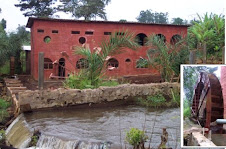Kennedy is currently the person heading up the Jiko project at ACREST. He arrived at ACREST in October of 2008 and started working on the stoves, which are called liners. He has made 98 liners; 12 cracked because of the gauge. He is also heading up the construction of the “better born kiln” (to be written about in another blog entry) for the mass firing of the jikos. They sold the first jikos in February of 2009 and have sold about seventy since. Recently, the main tasks have been collecting clay for the stoves from a riverbank, drying and sifting the clay, constructing the kiln, and production of the stoves. Right now, there are 88 more stoves ready to be burned and 64 ready for the metal cladding.
Tharaquet ceramic Jikos (T.C.J)
In one week, five people can make 100 energy-saving stoves. So in one month, you can get 400 energy saving-stoves, although it depends on weather. You must do your best on mixing and production so that you get 100% quality in all areas.
PROCEDURE
- Digging the Clay.
- Drying the Clay.
- Removing all impurities.
- Sand drying and Sieving.
- Soaking and Mixing (Ratio).
- Moulding of the liners (Jikos).
- Quality Control.
- Fixing the Pot-Rests.
- Drying the Stove (liner).
- Firing (adding value) 60% (value)
- Marketing *
- Ratio: Clay-2 Sand-1
- Installation and training.

No comments:
Post a Comment